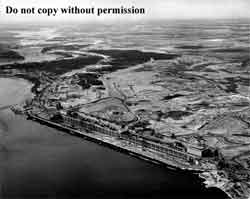Introduction
The St. Lawrence Seaway project was considered one of the major engineering feats of the twentieth century. First conceived as a hydro project, the Seaway project served the twofold purpose of providing much needed hydro resources and deepening the water levels in order for ocean freighters to gain access to the inland ports along the great lakes. However on July 1st, 1958, when the cofferdams, that had been holding back the water during construction, were finally blown apart, it signalled the end for a small group of riverside communities whose fate had been in limbo from the time discussions first began. This group of small communities became known as the 'Lost Villages'.
 Aerial view of St. Lawrence Powerhouse
Aerial view of St. Lawrence Powerhouse[ca. 1957]
Over the years we've had many inquiries about the Lost Villages. Since there were a total of nine communities involved as well as two American islands that we didn't include, it only made sense to organize it as a separate site. The purpose is to present an overview of the project history and a chronological history of the villages from the time they were first settled in the late 1700s until the end.
In addition to information on the flooded communities, we've also included information on the old villages of Iroquois and Morrisburg. Although both these communities continue to exist and thrive, their geography and history was substantially altered by the Seaway project.
If you are interested in additional material, be sure to visit our links section. Here you will find links to streaming archival television broadcasts, information for divers and a selection of places to visit. In particular, we've concentrated on museums where you can tour some of the historic buildings that were moved prior to the flooding. If you're on a genealogy quest, you'll also find links to genealogical groups in the area.
None of these villages were very big and the few photographs that exist are mainly in the hands of various historical groups, archives and collectors. We were very pleased to be able to obtain permission from John VanBaal at the Lost Villages Historical Society and Ian Bowering, Curator of the Stormont, Dundas and Glengarry Historical Society (S.D.& G.) to include a portion of their collection on this site. You can find a larger selection of the S.D. & G. photo collection, along with various other historical documents, at the Cornwall Public Library. Copies of many of these images are available for purchase at nominal cost. Contact information is available in our Copyright and credit section and catalogue numbers have been provided, where available.
The St. Lawrence Seaway project was over 40 years in the making but it only took four years to build. It cost a total of 470 million U.S. dollars, 71 per cent of which was paid by Canada, which receives a proportionate amount of the income derived from the Seaway. The Seaway was officially opened on April 25th, 1959. A ceremonial opening, presided upon by both the Canadian and U.S. governments, along with Queen Elizabeth took place two months later.
When the Seaway was conceived, it was thought to be the ultimate solution for Ontario's power woes. Now almost 50 years later, Ontario unfortunately finds itself in a similar postion, with no quick fixes like the Seaway lurking in the shadows. For various reasons, income from the Seaway has been drastically reduced. The introduction of zebra mussels, carried in by overseas freighters, has caused serious problems for the entire Great Lakes ecosystem. Nevertheless, it's easy to understand why, at the time, the Seaway was considered to be the great saviour
Although these villages are not ghost towns in the classical sense, they were ghost towns from the time the villagers were relocated to the day of the actual flooding. Small fragments of several of them continue to exist both above and below the floodline. They've also been commemorated in other ways such as in the names of some of the islands along the Long Sault Parkway, various parks and campgrounds.
We hope you enjoy the site. More galleries and historical photos will be added over the coming months.
